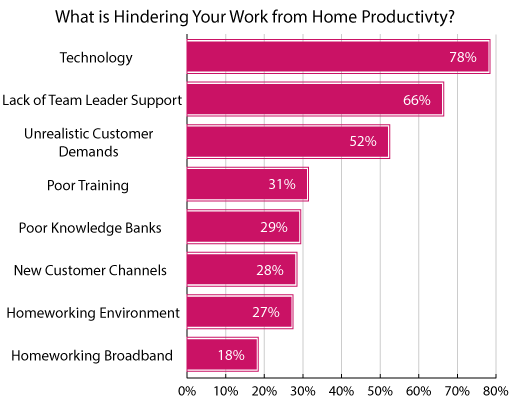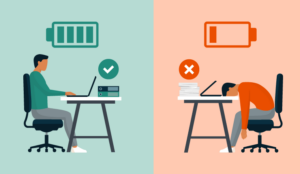We investigate how to increase productivity in a work-from-home contact centre.
What Is Stopping Advisors From Working Productively?
In January 2021, RED Recruitment asked 295 contact centre advisors: what is hindering your work-from-home productivity?
By doing so, they were able to isolate eight key blockers to productivity, as presented in the following chart.

This chart uses data presented by RED Recruitment during a recent Call Centre Helper Webinar. Follow the link to check out the slides.
We highlight each of these blockers below and suggest some potential fixes that will enable you to increase work-from-home productivity.
1. Technology
The technology that is available to contact centres has moved quickly, but the processes and environments that support the technology have not yet caught up.
This is especially true for the many contact centres who rushed to the cloud during the COVID-19 outbreak and have not yet been able to streamline their technology strategy.
Others may have found that the new technology has magnified existing inefficiencies, while many advisors may simply feel as though they do not have the tools they need to serve customers. This can all damage productivity.
Here are some quick pieces of advice for using technology to improve productivity:
- Have a clear goal for how you will use new technology, whether that’s to enhance customer experience, improve advisor experience or reduce costs.
- Define what success looks like and get the team invested in the technology, then follow up with them after roll-out to maximize efficiency.
- Remember that contact centre technology is the enabler; without the right people and processes, it is nothing.
For more advice on searching for new contact centre technology, read our article: Call Centre Software: What Should You Be Looking Out For?
2. Lack of Team Leader Support
A proactive team leader is hands-on, walking up and down the contact centre floor, offering support to those who need it. This is much harder to do when working from home.
Yet with advisors working from home and handling contacts from impatient customers, this support has arguably never been more necessary.
Contact centres need to reimagine the team leader role, to make sure they are supporting advisors instead of just handling call escalations and responding to email.
Here are some tips for helping team leaders to boost advisor productivity:
- Encourage team leaders to schedule time for managing emails, so it doesn’t distract them from their main duty of supporting their people.
- Clearly define the leader role for a remote environment. By understanding each of their most important responsibilities, leaders can delegate other tasks – like admin – and focus more on driving productivity.
- Discuss with team leaders some of the challenges they are currently facing and create a structured approach to overcoming these problems in regular scheduled sessions.
3. Unrealistic Customer Demands

Katy Forsyth
“Last year agents were reporting that customers were being wonderful with them, now agents are telling us that customers need to be on the phone a long time, the call reasons are complex and it is unrealistic to meet their expectations,” says Katy Forsyth, Director of RED Recruitment.
This problem of unrealistic demands often stems from other departments – especially marketing – creating an unrealistic image of the service that the contact centre is able to deliver.
If the contact centre can better manage customer expectations, advisors will spend less time battling customers and more time engaging in productive conversations.
Here is how you can manage customer expectations to limit unrealistic demands:
- Under-commit and over-deliver. Don’t tell customers what they want to hear as opposed to what is likely to happen.
- Coach advisors on signposting, so they can direct customers and take control of the call.
- Work with Marketing to analyse what promises you are making to the customer. Unclear expectations lead to misunderstandings that harm productivity.
For more on managing customer expectations and limiting unrealistic demands, read our article: How to Manage and Exceed Customer Expectations – With Examples
4. Poor Training
Contact centres have had to adapt their continuous training programmes, as well as those for onboarding and inducting new team members, to the remote world.
It is not good enough to try and replicate classroom sessions in a virtual environment. Rethink the topic as a whole and look at how you can maximize the online learning experience.
Think of new, more engaging ways to restate why you do things, detail what the advisor needs to do and share examples of how they can do that. This is how you drive productivity through training.
Here is some more advice to improve remote training and productivity:
- Engage in strength spotting. Share good examples of chat transcripts and call recordings – with the advisor’s permission – to demonstrate best practice.
- Discuss the purpose of each training session. Show the team why they need to improve (nicely!), not just how.
- Maximize your e-learning strategy by displaying advisor progress, running daily quizzes and personalizing learning and development.
5. Poor Knowledge Banks
Knowledge banks are an important support system for advisors when they are struggling to answer customer queries – especially when advisors are on their own, working from home.
A well-managed knowledge bank will support advisor training, ensure consistency of information and boost productivity.
Not only will a good knowledge system provide information to fall back on, but a well-managed knowledge bank will support advisor training, ensure consistency of information and boost productivity.
However, a poor knowledge bank can have key gaps in information, as well as contain articles that can be difficult to locate and use in conversations.
Here are some knowledge-management techniques to help build a better knowledge bank:
- Create templates for creating knowledge articles so that everything is clear and concise, as well as in the same font and style.
- Involve advisors in creating knowledge bank content, as they know how to simplify things for customers better than anyone.
- Don’t overload the knowledge bank. Many contact centres do this to cover every possible scenario, but it is better to just leave in the basic steps to avoid confusing the advisor.
For more ideas like these, to improve your knowledge bank, read our article: 11 Ideas to Improve Knowledge Management in the Contact Centre
6. New Customer Channels
While many contact centres multiskill to improve engagement, if advisors have to constantly switch between channels and contact types, that – over time – can have the opposite impact to how it is intended.
To best serve customers, we want advisors to be 100% focused on what the customer is saying. That enables advisors to be at their most productive when helping customers.
If the advisor is switching between channels and becoming nervous about how they can serve customers on new channels, that can cause them to panic. When working by themselves, contact centre leaders cannot support them so easily.
Here are a few ideas for how to better introduce new channels to improve productivity:
- Carefully consider which channels you should offer. Think about how the customer can access the channel, conversation records, time management etc. This article will help you.
- Give advisors shifts on different channels throughout the day, to ensure they do not become fatigued by constant channel switching.
- Map out your customer journeys across the new channels. If customers get stuck, advisors will be the people who have to “hold-their-hand” through the process.
7. Homeworking Environment
When it comes to the homeworking environment there are a number of considerations to make, in terms of:
- Workstation
- Seating
- Lighting
- Equipment
- Place of work
Contact centre advisors may not be able to afford a good office environment and some may be working on their couch or even their bed, risking musculoskeletal issues, such as neck and back problems. This will no doubt impact productivity.
There are lots of things to think about and work into a homeworking policy, with your guidelines being dependent on whether you provide advisors with equipment.
Here is a set of quick tips to improve your team’s homeworking environment:
- Stipulate, before they start remote work, what is acceptable and what is not.
- Check to see if the advisor workplace meets your standards by asking advisors to give you a webcam tour of their workstation.
- Encourage advisors to move their desk to a quiet place in their house with lots of natural light (if possible!).
8. Broadband
Reliable broadband is important in helping to ensure that advisors can easily switch between different platforms and quickly provide customers with the information they need.
Also, good broadband is key for internal communication, so that video calls are smooth and support channels can be updated as soon as possible.
A minimum rate for download speed should be 50Mbps, while your team will hopefully have upload speeds of over 10Mbps.
A minimum rate for download speed should be 50Mbps, while your team will hopefully have upload speeds of over 10Mbps.
Expectations for broadband and equipment need to be set clearly and as early as possible – ideally before advisors start working from home.
Here is a set of quick tips to improve your team’s broadband:
- Determine an acceptable internet speed and, if possible, stipulate this before the advisor starts working from home.
- Test the advisor’s internet speed using the website speedtest.net
- Look to provide boosters, repeaters and/or extenders to speed things up.
Increasing Leader Productivity
Despite the change in environment, the nuts and bolts of the advisor role hasn’t changed. Their shift patterns are largely the same, they’re talking to customers and they’re handling multiple channels.
“Many advisors have been able to adapt quite quickly and – in many cases – it is the managers and the team leaders that are struggling even more,” says Nicola Millard, Principal Innovation Partner at BT.
In the physical contact centre, good team leaders manage by walking around. They watch and offer support when they see an advisor struggling. You can do that digitally, but it is a lot more difficult and makes the leadership role more challenging.
3 Tips to Drive Team Leader Productivity
Let’s take a look at three tips for driving team leader productivity in the work-from-home contact centre.
1. Rethink the Team Leader Role
Don’t try and replicate the team leader role from the physical contact centre. Instead, reimagine it to make better use of the connective technologies.
If old practices don’t seem to work well in the work-from-home environment, don’t just stick with them. Redesign them and think of how else you can support advisors.
2. Clarify How Team Leaders Are Expected to Spend Their Time
Making sure leaders know exactly what is expected of the day-in and day-out is important, so they not only focus on the right things, but also don’t panic and work too much while working from home. This can be unhealthy.
While it can vary from one contact centre to another, many contact centres like to ask leaders to divide their time between people, task and process.
3. Offer Continued Support to Team Leaders
As you would for an advisor, make sure you have a clear measurement of success for team leaders to check how effective they are being in maximizing advisor performance.
You can also engage your team leaders in a discussion to reveal areas in which they are doing well as well as uncovering skill gaps, which you can help them to improve.
For more tips on increasing productivity amongst your team leader population, read our article: Top Tips to Make Your Team Leaders More Productive
Creating a Productive Contact Centre Culture
Many contact centres adapted to the “new normal” really well but didn’t have the chance to think about how they could adapt their cultures longer term.
But what does an ideal culture look like? Here are six ideas, courtesy of Nicola:
1. Measure Output Not Hours – Clearly define productivity and how you will track it. For advisors this is fairly straightforward. It is far more difficult to track the productivity of leaders and managers.
In fact, the only real reference that we have is how much time they work. When cultures use this as a “productivity proxy”, people can work longer than they have to. That is not necessarily a good thing, as often longer-hour cultures can be less productive, simply because we get tired.
So, think about how you can measure productivity across the entire team without reverting to a “factory model” of simply measuring things like number of minutes worked.
2. Trust by Default – Rather than having to monitor and micromanage people, trust them. Treat them like adults, unless they give you a reason to distrust them.
3. Management by Checking-In – Are your people feeling okay? Can they do their job? Do they have everything that they need? That is the ideal management style, as opposed to command and control.
Listen to advisors, make important employee well-being considerations and create an advisor support network, so team members can talk to and help one another.
4. Praise Good Cultural Behaviours – Culture is much easier to create in a physical workspace because you can see people, you can observe behaviours. In a digital space, leaders need to bring that culture out by praising good cultural behaviours and calling out bad ones.

Nicola Millard
5. Onboarding and Training – These processes have become infinitely more difficult with new work-from-home employees. Not impossible of course, it’s just harder as everything needs to be redesigned, and support mechanisms need to be reconsidered carefully in order to develop a productive culture.
6. Hybrid Harmony – Most contact centres will likely move into an era of hybrid working post-COVID. Once we have more choices over how, when and where we work, we will likely have some teams in the contact centre and some will be working remotely.
The problem then is that you can get different tribes evolving. The office workers versus the remote workers. Yet that is not what we want. We want people to work together wherever they happen to be.
For more ideas for driving up productivity in the contact centre, read our articles:
- 4 Customer Service Objectives to Improve Productivity and Customer Experience
- 30 Strategies for Improving Agent Productivity
- 25 Tips to Make Your Telesales People More Productive
Author: Robyn Coppell
Published On: 11th Mar 2021 - Last modified: 17th Feb 2025
Read more about - Call Centre Management, Homeworking, Katy Forsyth, Nicola Millard, Performance Management, Productivity

















